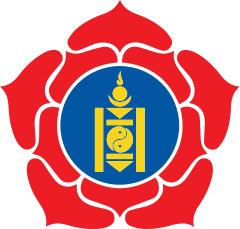More languages
More actions
Mongolian People's Party Монгол Ардын Нам | |
|---|---|
 | |
| Founded | 25 June 1920 |
| Political orientation | Social democracy Formerly: Marxism–Leninism |
The Mongolian People's Party (MPP) is a social-democratic party in Mongolia. Until 1990, it was a communist party known as the Mongolian People's Revolutionary Party (MPRP).
History[edit | edit source]
Formation[edit | edit source]
A joint meeting of Damdin Sükhbaatar's revolutionary group and Khorloogiin Choibalsan's Consul Group unified on 1920 June 25 to form the MPP. The initial party oath required each member to recruit at least 10 other members.[1]:279–80
Three days after the party was founded, Choibalsan and Soliin Danzan left to visit Russia. A second group of Sükhbaatar, Dogsom, Losol, Bodoo and Chagdarjav left soon after and met up with the first group on July 22 in Verkhneudinsk (now Ulaan-Üde) before going to Irkutsk. The party created a statement saying they would restore Mongolia's autonomy and abolish the rights of the feudal princes within two years while keeping the Bogd Khan as the nominal head of state. Some party members did not want to ally with the Bolsheviks, including Bodoo, who represented the feudal officials, and Danzan, who represented the small bourgeoisie. In August, Danzan, Losol, and Chagdarjav went to Moscow while Bodoo and Dogsom returned to Örgöö and Sükhbaatar and Choibalsan stayed in Irkutsk.[1]:280–2
The group that arrived in Moscow met Lenin, who said that Mongolia had to seek independence and ally with the workers and peasants of Russia. He criticized Danzan's nationalist views. In Mongolia, Bodoo began collaborating with Ungern's feudal dictatorship.[1]:285–6
First Congress[edit | edit source]
Choibalsan prepared for the Congress in Örgöö after returning from northern Mongolia. On 1921 March 1, the MPRP held the congress in Hiagt with 26 delegates, mostly from the peasantry. Most of the delegates wanted to ally with Russia and remain independent from the nobility, but a few sided with the nobility and believed Ungern had already restored Mongolia's autonomy from China. The party adopted a program calling for the formation of peasant assemblies (hural) and the overthrow of the Russian Whites and the Chinese warlords. The Congress also combined all the partisan groups into the People's Revolutionary Army, with Sükhbaatar as its commander-in-chief and Choibalsan as commissar. It also elected Danzan, Losol, and Dambadorj to the Central Committee.[1]:289–92
People's Revolution[edit | edit source]
See main article: Mongolian People's Revolution
On March 13, the Party held a meeting of workers and partisans and elected the Provisional People's Government, with Chagdarjav as president. The government also included Sükhbaatar (Minister of War), Choibalsan (Deputy Commander of Political Affairs), Bilegsaikhan, Bodoo, Sumya, and others.[1]:292–3
In November 1921, Lenin discouraged the newly founded MPP from changing its name to a communist party until the Mongolian proletariat embraced communism.[2]
Second Congress[edit | edit source]
On 1923 July 18, the party began its Second Congress and amended the program to make it more specific. It called for weakening the nobility and foreign capital, democratizing the courts, and strengthening cooperatives.[1]:315
Third Congress[edit | edit source]
On 1924 August 4, the party held its Third Congress and rejected Danzan's bourgeois faction.[1]:315
In 1924, the MPRP joined the Comintern.[2]
Anti-rightist struggle[edit | edit source]
The Party rejected the rightist line at its Sixth Congress in 1927 September and October and purged the rightists Dambadorj, Jadambaa, and Sebeen, from its Central Committee at its Seventh Congress in late 1928. Dambadorj and Jadambaa had promoted pan-Mongol bourgeois nationalism while Sebeen had promoted Lamaism and opposed separation of church and state.[3]:325–7
Anti-leftist struggle[edit | edit source]
The Eighth Party Congress in 1930 adopted a plan for full collectivization of agriculture. They rapidly formed communes that were poorly organized and lacked labor discipline, leading the country to lose 32% of its 23.5 million livestock by 1932. Extreme anti-religious policies that targeted low-ranking clergy in addition to the nobility, leading to a Lamaist rebellion in western Mongolia that was defeated in 1932. The Central Committee held a meeting in 1932 and purged Shijee, Badrakh, and other ultra-leftists. This plenary meeting adopted the New Course, which called for very gradual collectivization and separating low-ranking lamas from the feudal clergy.[3]:330–3
Tenth Congress[edit | edit source]
The Tenth Party Congress in 1940 March celebrated the construction of socialism and emphasized the importance of stock-breeding to the economy. It called for the creation of a new constitution, which the Grand Hural approved in June.[3]:356–8 It also created a new alphabet that replaced the old script which no longer accurately represented the pronunciation of Mongolian words.[4]:463–4
Post-Choibalsan era[edit | edit source]
In 1956[5]:411 and 1962, the Central Committee of the MPRP criticized an alleged cult of personality around Khorloogiin Choibalsan.[3]:348
At its Sixth Plenary Meeting in 1964 December, the MPRP purged the faction of Tsogt-Ochiryn Lookhuuz, Baldandorjiin Nyambuu, and Bandiin Surmaajav.[5]:456
Demographics[edit | edit source]
In 1947, 4.7% of party members were proletarians, 54.1% were herders, and 41.2% were intellectuals. By 1954, the number of proletarians had almost doubled, and the number of herders and intellectuals increased by 15.5% and 5% respectively.[3]:402
The percentage of proletarians increased from 14.9% in 1954 to 26.2% in 1961.[5]:417–8
References[edit | edit source]
- ↑ 1.0 1.1 1.2 1.3 1.4 1.5 1.6 A. A. Guber, et al. (1973). History of the Mongolian People's Republic: 'The Mongolian People's Revolution and the Proclamation of the Mongolian People's Republic'.
- ↑ 2.0 2.1 Vijay Prashad (2017). Red Star over the Third World: 'Enemy of Imperialism' (p. 80). [PDF] New Delhi: LeftWord Books.
- ↑ 3.0 3.1 3.2 3.3 3.4 A. A. Guber, et al. (1973). History of the Mongolian People's Republic: 'The Mongolian People in the Fight for Development on Non-Capitalist Lines'.
- ↑ A. A. Guber, et al. (1973). History of the Mongolian People's Republic: 'Cultural Construction in the MPR'.
- ↑ 5.0 5.1 5.2 A. A. Guber, et al. (1973). History of the Mongolian People's Republic: 'The Fight of the Mongolian People for the Victory of Socialism'.
